While there are less than 500 species of Plumbaginaceae in the world today, there are very few places you could go and not encounter one of them if you looked for them. The most likely place to encounter leadworts are dry areas with saline soils, such as salt flats and sea coasts, especially in the Mediterranean and western Asia.
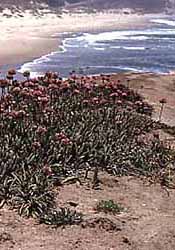 |
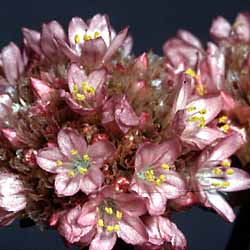 |
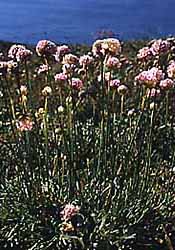 |
Extreme habitats : The california native Armeria maritima var. californica (Sea-Pink) is one of only two species of Plumbaginaceae native to the state of California. The epithet "maritima" refers to its preferred habitat. This species grows on exposed grasslands in coastal regions, and may even be found on ocean bluffs and on the sand at the ocean's edge. Few other species of flowering plants can cope with the high levels of salt found in these soils.
The Plumbaginaceae are mostly herbs and small shrubby plants. Many species have all or most of their leaves clustered at the base of the plant, and these leaves have chalk-glands. The glands are a key feature that allows members of the family to live in salty soilswhere most other species of plants cannot. The chalk-glands excrete calcareous salts dissolved in the water of the plant's tissues. This excretion moves the salts out of the plant where they may crystallize or be washed away.
The flowers have five petals, five stamens, and five sepals that may be colorful and showy like the petals, but which are often thin and papery. The flowers may be pink or blue, and are usually clustered together. Unlike most members of the family, the flowers of Plumbago often have the bases of the petals fused together into a long tube, but with the five petal tips separate. This floral shape, and the blue color, are typical characteristics of flowers that are attractive to butterflies.
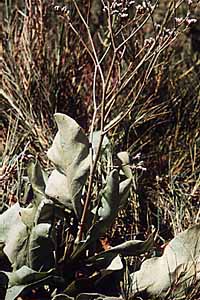 |
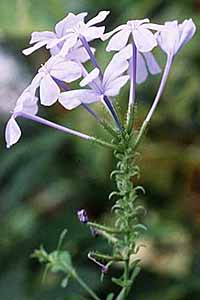 |
Diversity of Form : Above at left, Limonium californicum, a member of the subfamily Armerioideae that grows in disturbed areas. At right, Plumbago auriculata, a member of the other subfamily Plumbagoideae. Species of Plumbago superficially resemble Phlox in the Polemoniaceae, but a quick check for glands on the sepals will easily distinguish Plumbago. You can see these glands on the green sepal tubes at the base of the flowers in the picture above. (Click on either of the pictures above for a larger image).
Fossils of the Plumbaginaceae are not common, but pollen from both subfamilies is known from the Miocene. Fossil pollen that resembles pollen of living Aegialitis and Plumbago (both in subfamily Plambagoideae) has been reported from the Upper and Middle Miocene of Borneo, respectively. Fossil pollen comparable to either living Armeria or Limonium is known from the Upper Miocene of Spain. While the Plumbaginaceae fossil record extends only back to the Miocene, that of their sister group, the Polygonaceae extends back as least as far as the Paleocene. See Muller (1981) for more information.
As for the name of the group -- Plumbaginaceae -- you might have noticed that it resembles the Latin word plumbum which means "lead", and hence the common name of the group is the leadworts ("lead-plants"). But what do these plants have to do with lead? That seems to be something of a mystery. Paxton's Botanical Dictionary, published in London in 1868, suggests that the name actually derives from the name of an eye disorder (plumbum) which some species of Plumbago were believed to treat. It is true that many species in the family have medicinal properties, notably as cure for toothache and as a skin astringent, but I have not been able to confirm that there was ever an eye disorder by the name "plumbum". More recently, Channell and Wood have speculated that the name comes from the lead-gray color produced by the calcareous salty coating the chalk glands exude. If someone out there knows the story behind the name Plumbago and Plumbaginaceae, please do let us know!


